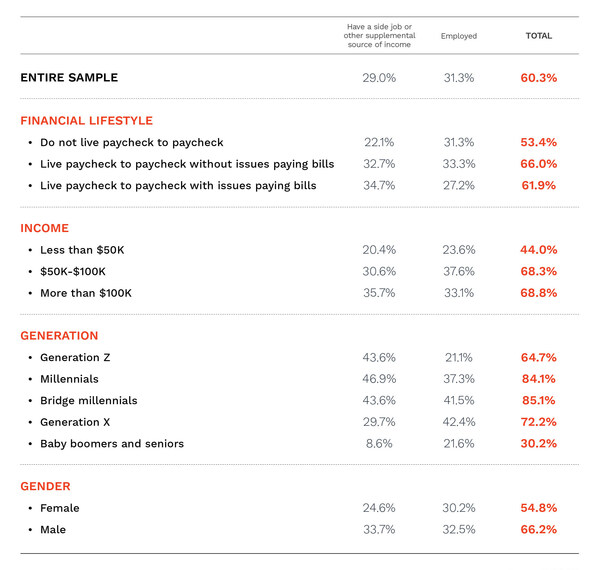Sixty-two percent of adult U.S. consumers live paycheck to paycheck as of February 2023. Although this represents a slight rise from 60% in January, year-over-year the share of consumers living paycheck to paycheck has remained steady.
When looking at the two categories of paycheck-to-paycheck consumers — those who can pay their monthly bills without difficulty and those who struggle to do so — the data shows recent shifts in financial lifestyle that indicate consumers have adjusted to inflationary pressures, finding ways to better manage their cash flows. For example, fewer consumers overall reported struggling to pay bills in February 2023. Moreover, fewer low-income consumers report living paycheck to paycheck with issues paying their bills than did so one year ago, and the share of those living without difficulty has increased slightly.
“While consumers have adjusted to inflationary pressures by budgeting and spending less, many have turned to supplemental income with a side job or alternative income sources to improve their financial standing,” said Anuj Nayar, Financial Health Officer at LendingClub. “A vast majority of consumers became used to working from home during the pandemic, and after returning to work, many kept flexible hours and turned to alternative income streams to expand their earning potential beyond a 9-to-5 job.”
Sixty percent of consumers surveyed say they are employed, with nearly half of this group also holding a side job or earning some other form of supplemental income. In fact, 27% of high-income and 26% of middle-income consumers say they have side jobs. One point of differentiation among consumers is that high-income consumers are more likely than average to receive supplemental income that does not derive from a side job: 24% do so, while only 17% of all consumers receive other supplemental income.
For consumers not living paycheck to paycheck who had a side job in the last six months, 70% said they opted for the side job because the income was easy to earn and 56% said their motivation was enjoying doing the job. Furthermore, more affluent consumers are likely to have side jobs or earn income from informal tasks or selling artisan or used products. These alternative income sources are often accessed via online marketplaces, such as Etsy and eBay for artisan or used products, or in the case of informal tasks, via mobile apps like TaskRabbit.
In contrast, struggling consumers are the financial lifestyle most likely to report that the reason they have a side job is that their current income is not enough to pay all their bills (46%). They are also the most likely to say that they earn income from informal tasks or selling artisan or used products because their current income is not enough to pay all their bills (35%).
Supplemental income tends to come from active engagement (such as selling used items or selling artisan products) and 22% of employed consumers received supplemental income in the last three months. Approximately one-tenth of workers cited receiving passive income or some form of financial aid. Consumers that do not live paycheck to paycheck are more likely to receive passive incomes from investments and rental properties, and paycheck-to-paycheck consumers struggling to pay their bills are the most likely to turn to friends and family for financial aid.
According to the data, consumers could be amassing a collective $52 billion in cash payments each month related to active side incomes. In the last three months, 55% of respondents who received supplemental income for at least one year have seen its share increase compared to their total monthly income. Consumers living paycheck to paycheck with issues paying bills and those earning more than $100,000 annually are significantly more likely to have a growing supplemental income, at 62% each. Tips and product resales are the activities most associated with cash payments, with up to 50% made this way. Moreover, some consumers may prefer cash because they think they can shelter it from taxes: 28% of consumers said their alternative sources of income are undeclared.
The data shows that across all supplemental income streams tracked, consumers have received these funds for an average of just 15 months. Not surprisingly, consumers not living paycheck to paycheck have received all forms of supplemental income for an average of 17 months, with retirement benefits, income from rental properties, and profits from investments the sources these consumers held the longest. In contrast, paycheck-to-paycheck consumers struggling to pay bills have received all supplemental incomes for an average of 12 months, meaning their supplemental income is generally newer. While these paycheck-to-paycheck consumers have received some sources of supplemental income for longer periods of time, such as government benefits for an average of 19 months and money from relatives or friends for an average of 16 months, they are just starting to receive supplemental income from active sources, such as receiving profits from selling used items for an average of 10 months.
The data suggests that supplemental income will continue to gain importance moving forward, as 51% of those who have not received a supplemental income in the last three months are at least somewhat likely to seek another income source in the next 12 months.
“As pandemic-related financial benefits were pulled back by the government, more and more people turned to alternative income to make ends meet and manage their cash flow,” continued Nayar. “What is clear: no matter your income bracket, having supplemental income greatly impacts financial stability and can often mean the difference between living without difficulty and living paycheck to paycheck and struggling to pay monthly bills,” continued Nayar.
View the full report here.






















